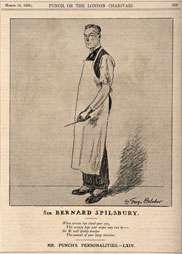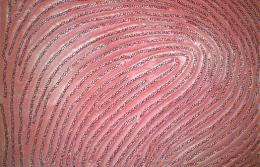Sir Bernard Spilsbury, 1928. Credit: Wellcome Library, London
Historians tend to see the birth of DNA fingerprinting in 1985 as a watershed in forensic investigation - the moment that gave birth to the systematic crime scene analysis we associate with TV programmes like CSI today. At the University of Manchester, Dr Ian Burney argues that a model of systematic crime scene analysis pre-dated DNA evidence.
Detectives opening an 80-year-old burial vault find one of its occupants has vanished. Yet there is no sign of disturbance: a uniform layer of dust covers the tombs, floor and every horizontal surface. In fact, it is the scene's very lack of sensation that holds the key to the mystery. Analysis of dust from the different surfaces under a microscope reveals that the dust on the empty tomb has a faint red tinge, indicating that it originated outside of the vault, in a room with a red carpet. The tomb has indeed been disturbed, and the criminals responsible tried to cover their traces by spreading a layer of dust over it.
This is the story that unravels in Austin Freeman's 1933 detective novel 'Dr Thorndyke Intervenes'. The crucial role of dust in the story reflects a new forensic model emerging at the time, centred on meticulous recording and excavation of the crime scene and the (almost invisible) traces left by the criminal. It's an approach recognisable to fans of 'CSI' and other forensic TV dramas today.
"We tend to think that before Alec Jeffries' eureka moment in 1984, when he realized that genetic variations in DNA could identify individuals, crime investigations were really just guesswork," says Dr. Ian Burney at the University of Manchester. He has been awarded a Wellcome Trust Research Leave Award to explore 20th-century forensics before the 1980s.
Genetic fingerprinting: close-up of a human finger showing the pattern of whorls and ridges making up the fingerprint. DNA sequence has been overlaid to follow the unique pattern of the individual’s fingerprint. Credit: J Pendjiky and D Becker, Wellcome Images.
Our faith in DNA as an implacable witness to the absolute truth is reflected in the modern trend to overturn past convictions on the basis of modern DNA analysis. For many, as for Dr. Crippen, who was notoriously hanged for the murder of his wife in 1910, such reviews have come too late. Crippen's conviction 'hung' on the evidence of the pathologist, Sir Bernard Spilsbury, who insisted that the remains found in Crippen's basement were those of his wife, Cora. Last year forensic scientist Professor David Foran and colleagues declared that nuclear DNA testing on the same remains revealed a Y-chromosome, indicating that they weren't the remains of a woman.
The debate over Crippen's guilt or innocence pits two state-of-the-art and very powerful forensic models for producing truth against each other, both of which emerged in the early decades of the last century.
Sir Bernard Spilsbury was catapulted to fame over the Crippen case in 1910 - and with that case (and his role in it) - the cult of the celebrity pathologist was born: a lone hero and commanding presence in the mortuary and courtroom, feeding the public appetite for gore-filled tales and drama.
"Celebrity pathologists were oracles of a certain set of investigative practices centred on the mortuary, and ideally on a riot of confusing flesh, whether it's been chopped up or buried and in a state of putrefaction," says Dr. Burney. "The magic of these guys is to make this confused mess of flesh actually tell a joined-up story in the courtroom."
From within the enclosed space of the mortuary, the celebrity pathologist single-handedly reconstructed the details of the crime and, in virtuoso courtroom performances, often insisted on the accuracy of observations that could not easily be verified by their peers.
From the 1930s onwards the 'celebrity pathologist' began to be challenged by a new and contrasting forensic model - exemplified in the systematic analysis of dust in Freeman's novel, and elaborated in the writings of leading criminologists of the day, such as Hans Gross and Edward Locard.
Rather than relying on the medical opinion of a lone practitioner, this new model was rooted in a team-based, multi-disciplinary and scientific approach. Crucially, it was orientated towards the space around the body, rather than the body itself.
"You don't just go to the crime scene, haul the body off to the mortuary, and make that your sole investigative object. Because if you do you negate all the contextual clues about how the body actually lies in relationship to other, less immediately obvious or significant things at the scene."
Instead, the crime scene became an archaeological and ecological space, subject to systematic police and scientific investigation. The scene had first to be disciplined and restrained: nothing should be touched or moved until the position of every object in relation to everything else at the scene was recorded. The next step was to carry out an analytical 'excavation' or harvesting of traces, such as dust, hair and fingerprints. These were then taken back to one of the newly established police laboratories for analysis.
The same principles - painstaking recording of the scene and reconstruction of past events from the evidence in the laboratory - informed a new archaeological model that had begun to emerge. The new breed of archaeologists criticised the old-fashioned 'tomb raiders' for careless plundering and for focusing on superficially attractive objects rather than paying attention to the whole environment.
The bleeding obvious
"You no longer go to the most obvious big thing, the bleeding corpse. You look at less obvious things, like dust. You take them back to the laboratory and analyse them, asking what the traces on and around the corpse can tell you about the circumstances within which that person came to be a corpse," says Dr. Burney. "Locard said that the criminologist re-creates the criminal from traces left at the scene, just as the archaeologist reconstructs prehistoric beings from his findings."
It was Locard who in the 1920s emphasised the importance of dust as one of these 'traces'. He believed its distribution could bear testimony to what had taken place, and its composition, analysed under the microscope, to its source. He wrote about the significance of successive layers of dust under the sole of a shoe, citing a case in which a layer of flour dust between two of earth provided evidence of entry into a mill. "In one of his articles he recounted the details of around a dozen cases that had been solved by dust."
Hence Dr. Thorndyke's careful analysis of dust from the tomb in Freeman's novel. "Freeman was actively interested in educating his readers, the public, about dust and modern forensics. His Dr. Thorndyke was a more scientific Sherlock Holmes," says Dr. Burney. "In the Thorndyke stories, criminals knew about dust, but only as surface, as something that could simply register actions taking place upon it. But they failed to appreciate what Thorndyke knew - that dust could be reconstituted as an object in own right that could 'speak' and bear witness to its origins. They were smart, but not smart enough."
By the end of the 1930s, dust had begun to recede from forensic and public imagination, and today CSI teams do not feature specialists in dust analysis. However, its earlier role as one of the 'mute witnesses' or crime scene traces - more reliable and 'objective' than human witnesses, or celebrity pathologists, with their propensity to mislead - paved the way for modern CSI. "If you can get people to think that dust speaks, then you've created a world of expectation that trace evidences, hair, fiber, blood, ballistics etc, can do the work that used to only be done by pulped corpses." By the 1930s and 1940s, trace investigation had become a standard and routine part of forensic investigation.
The growing complexity of trace analysis demanded specialized knowledge and equipment beyond conventional autopsy practices at the mortuary slab. This, in turn, threatened to relegate the role and responsibilities of the forensic pathologist to that of harvesting material from the body for analysis by other experts, who might question the results of his own autopsy findings.
A new breed of 'modernized' celebrity pathologists managed to adapt their role to these new demands, however, by entering the crime scene itself, rather than remaining in the mortuary.
They were willing to be called out at all hours to a scene of horror, smell and intense labour, where they interacted cooperatively with the police and scientific investigators. Newspaper photographs of the 'heroic' celebrity pathologist captured in action in the field became a stock feature from the mid-20th century onwards.
An example was the serial murder investigation at John Reginald Halliday Christie's home at 10 Rillington Place in Notting Hill, London, in 1953. The forensic investigation led by modern celebrity pathologist Francis Camps unearthed the bodies of six women buried in the house and garden. Camps transformed Rillington Place into a macabre archaeological site - a spectacular stage on which to dramatise a prolonged, meticulous and multi-disciplinary search for and analysis of bio-evidence. For example, Christie had collected pubic hairs from his victims in a tin, and these were matched to the bodies. One point of contention was whether a tuft of hair that had been trimmed belonged to one of the victims (who didn't, in life, trim her pubic hair).
As a result of these and other high-profile investigations, and of their willingness to co-operate with other experts, mid-century pathologists managed to maintain overall command of police investigations. They were even put in charge of the new Home Office-sponsored police laboratories founded in the 1930s and 1940s, which were institutionalizing the new trace-orientated forensic model.
This presented sources of potential tension - between the forensic pathologist's established role as a custodian of a time-honoured medical practice, and as manager of routine, and tedious, laboratory work. "The two models can work in co-operation but can also be antagonistic to one another," says Dr. Burney. "I'm looking at the dynamic between them, how the tension plays out over the course of the century, at three sites: the crime scene, the laboratory and the courtroom."
He believes his findings will challenge the idea that there was a straightforward forensic watershed in 1985 with the advent of DNA fingerprinting, before which forensic investigation was stagnant, amateurish and lacking credibility. "I'm pretty sure I'll find many of the icons of post-DNA forensics were around before the 1980s. The white-suited scene of crime officers; concerns about 'chain of custody' and the management of the gap between crime scene and laboratory; and questions about standards and thresholds for interpreting trace evidence. They were all live concerns before DNA took centre stage."
Provided by Wellcome Trust























